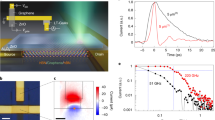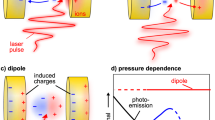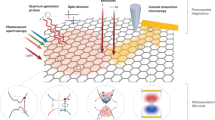Abstract
Photocurrent measurements provide a powerful means of studying the spatially resolved optoelectronic and electrical properties of a material or device1,2,3,4,5,6,7. Generally speaking there are two classes of mechanism for photocurrent generation: those involving separation of electrons and holes, and thermoelectric effects driven by electron temperature gradients. Here we introduce a new member in the latter class: the photo-Nernst effect. In graphene devices in a perpendicular magnetic field we observe photocurrent generated uniformly along the free edges, with opposite sign at opposite edges. The signal is antisymmetric in field, shows a peak versus gate voltage at the neutrality point flanked by wings of opposite sign at low fields, and exhibits quantum oscillations at higher fields. These features are all explained by the Nernst effect8,9,10 associated with laser-induced electron heating6,11,12,13,14. This ‘photo-Nernst’ current provides a simple and clear demonstration of the Shockley–Ramo nature of long-range photocurrent generation in a gapless material5.
This is a preview of subscription content, access via your institution
Access options
Subscribe to this journal
Receive 12 print issues and online access
$259.00 per year
only $21.58 per issue
Buy this article
- Purchase on SpringerLink
- Instant access to full article PDF
Prices may be subject to local taxes which are calculated during checkout




Similar content being viewed by others
References
Zhong, Z., Gabor, N. M., Sharping, J. E., Gaeta, A. L. & McEuen, P. L. Terahertz time-domain measurement of ballistic electron resonance in a single-walled carbon nanotube. Nature Nanotech. 3, 201–205 (2008).
McIver, J. W., Hsieh, D., Steinberg, H., Jarillo-Herrero, P. & Gedik, N. Control over topological insulator photocurrents with light polarization. Nature Nanotech. 7, 96–100 (2012).
Drexler, C. et al. Magnetic quantum ratchet effect in graphene. Nature Nanotech. 8, 104–107 (2013).
Mak, K. F., McGill, K. L., Park, J. & McEuen, P. L. The valley Hall effect in MoS2 transistors. Science 344, 1489–1492 (2014).
Song, J. C. W. & Levitov, L. S. Shockley–Ramo theorem and long-range photocurrent response in gapless materials. Phys. Rev. B 90, 075415 (2014).
Gabor, N. M. et al. Hot carrier–assisted intrinsic photoresponse in graphene. Science 334, 648–652 (2011).
Nazin, G., Zhang, Y., Zhang, L., Sutter, E. & Sutter, P. Visualization of charge transport through Landau levels in graphene. Nature Phys. 6, 870–874 (2010).
Zuev, Y. M., Chang, W. & Kim, P. Thermoelectric and Magnetothermoelectric transport measurements of graphene. Phys. Rev. Lett. 102, 096807 (2009).
Wei, P., Bao, W., Pu, Y., Lau, C. N. & Shi, J. Anomalous thermoelectric transport of Dirac particles in graphene. Phys. Rev. Lett. 102, 166808 (2009).
Checkelsky, J. G. & Ong, N. P. Thermopower and Nernst effect in graphene in a magnetic field. Phys. Rev. B 80, 081413 (2009).
Song, J. C. W., Rudner, M. S., Marcus, C. M. & Levitov, L. S. Hot carrier transport and photocurrent response in graphene. Nano Lett. 11, 4688–4692 (2011).
Ma, Q. et al. Competing channels for hot-electron cooling in graphene. Phys. Rev. Lett. 112, 247401 (2014).
Sun, D. et al. Ultrafast hot-carrier-dominated photocurrent in graphene. Nature Nanotech. 7, 114–118 (2012).
Graham, M. W., Shi, S.-F., Ralph, D. C., Park, J. & McEuen, P. L. Photocurrent measurements of supercollision cooling in graphene. Nature Phys. 9, 103–108 (2013).
LeeEduardo, J. H., Balasubramanian, K., Weitz, R. T., Burghard, M. & Kern, K. Contact and edge effects in graphene devices. Nature Nanotech. 3, 486–490 (2008).
Park, J., Ahn, Y. H. & Ruiz-Vargas, C. Imaging of photocurrent generation and collection in single-layer graphene. Nano Lett. 9, 1742–1746 (2009).
Xu, X., Gabor, N. M., Alden, J. S., van der Zande, A. M. & McEuen, P. L. Photo-thermoelectric effect at a graphene interface junction. Nano Lett. 10, 562–566 (2009).
Liu, C.-H., Chang, Y.-C., Norris, T. B. & Zhong, Z. Graphene photodetectors with ultra-broadband and high responsivity at room temperature. Nature Nanotech. 9, 273–278 (2014).
Lemme, M. C. et al. Gate-activated photoresponse in a graphene p–n junction. Nano Lett. 11, 4134–4137 (2011).
Urich, A., Unterrainer, K. & Mueller, T. Intrinsic response time of graphene photodetectors. Nano Lett. 11, 2804–2808 (2011).
Song, J. C. W., Reizer, M. Y. & Levitov, L. S. Disorder-assisted electron-phonon scattering and cooling pathways in graphene. Phys. Rev. Lett. 109, 106602 (2012).
Betz, A. C. et al. Supercollision cooling in undoped graphene. Nature Phys. 9, 109–112 (2013).
Johannsen, J. C. et al. Direct view of hot carrier dynamics in graphene. Phys. Rev. Lett. 111, 027403 (2013).
Tielrooij, K. J. et al. Photoexcitation cascade and multiple hot-carrier generation in graphene. Nature Phys. 9, 248–252 (2013).
Yan, J. et al. Dual-gated bilayer graphene hot-electron bolometer. Nature Nanotech. 7, 472–478 (2012).
Lui, C. H., Mak, K. F., Shan, J. & Heinz, T. F. Ultrafast photoluminescence from graphene. Phys. Rev. Lett. 105, 127404 (2010).
Shockley, W. Currents to conductors induced by a moving point charge. J. Appl. Phys. 9, 635–636 (1938).
Ramo, S. Currents induced by electron motion. Proc. IRE 27, 584–585 (1939).
Miao, F. et al. Phase-coherent transport in graphene quantum billiards. Science 317, 1530–1533 (2007).
Freitag, M. et al. Energy dissipation in graphene field-effect transistors. Nano Lett. 9, 1883–1888 (2009).
Balandin, A. A. et al. Superior thermal conductivity of single-layer graphene. Nano Lett. 8, 902–907 (2008).
Luk’yanchuk, I. A., Varlamov, A. A. & Kavokin, A. V. Giant Nernst–Ettingshausen oscillations in semiclassically strong magnetic fields. Phys. Rev. Lett. 107, 016601 (2011).
Jonson, M. & Girvin, S. M. Thermoelectric effect in a weakly disordered inversion layer subject to a quantizing magnetic field. Phys. Rev. B 29, 1939–1946 (1984).
Wang, Y., Li, L. & Ong, N. P. Nernst effect in high-TC superconductors. Phys. Rev. B 73, 024510 (2006).
Behnia, K., Méasson, M.-A. & Kopelevich, Y. Oscillating Nernst–Ettingshausen effect in bismuth across the quantum limit. Phys. Rev. Lett. 98, 166602 (2007).
Acknowledgements
We thank B. Spivak, A. Andreev, D. Xiao and C. Laumann for discussions. This work was supported by the National Science Foundation (NSF, DMR-1150719). The experimental set-up was partially supported by DoE BES (DE-SC0008145). Z.F. and D.H.C. are supported by DoE BES (DE-SC0002197). This material is based in part upon work supported by the State of Washington through the University of Washington Clean Energy Institute. Device fabrication was performed at the University of Washington Microfabrication Facility and the NSF-funded Nanotech User Facility.
Author information
Authors and Affiliations
Contributions
X.X. conceived the experiment; G.A. built the experimental set-up; H.C. performed the experiments, assisted by G.A.; H.C., Z.F. and J.R. fabricated the devices; H.C., X.X., D.H.C. and Z.F. analysed the results; Z.F. and D.H.C. did the modelling; and H.C., D.H.C. and X.X. wrote the paper with comments from all authors.
Corresponding authors
Ethics declarations
Competing interests
The authors declare no competing financial interests.
Supplementary information
Supplementary information
Supplementary information (PDF 826 kb)
Rights and permissions
About this article
Cite this article
Cao, H., Aivazian, G., Fei, Z. et al. Photo-Nernst current in graphene. Nature Phys 12, 236–239 (2016). https://doi.org/10.1038/nphys3549
Received:
Accepted:
Published:
Issue date:
DOI: https://doi.org/10.1038/nphys3549
This article is cited by
-
Visualization of bulk and edge photocurrent flow in anisotropic Weyl semimetals
Nature Physics (2023)
-
Photocurrent as a multiphysics diagnostic of quantum materials
Nature Reviews Physics (2023)
-
Infrared nano-imaging of Dirac magnetoexcitons in graphene
Nature Nanotechnology (2023)
-
Ultrafast photothermoelectric effect in Dirac semimetallic Cd3As2 revealed by terahertz emission
Nature Communications (2022)
-
Non-local terahertz photoconductivity in the topological phase of Hg1−xCdxTe
Scientific Reports (2021)



